Screenplay Format Tips
You’ve got a great idea for a movie but you’re not sure where to start with writing a script. This blog will walk through some of the ins and outs of the screenplay format, why it’s important, and how to write a screenplay.
Screenwriting format serves as a great tool when writing to keep your ideas clear and your script cohesive. Writing with proper formatting also gives your script legitimacy, and it lets people reading it know that you know what you’re doing.
What Is Screenplay Format?
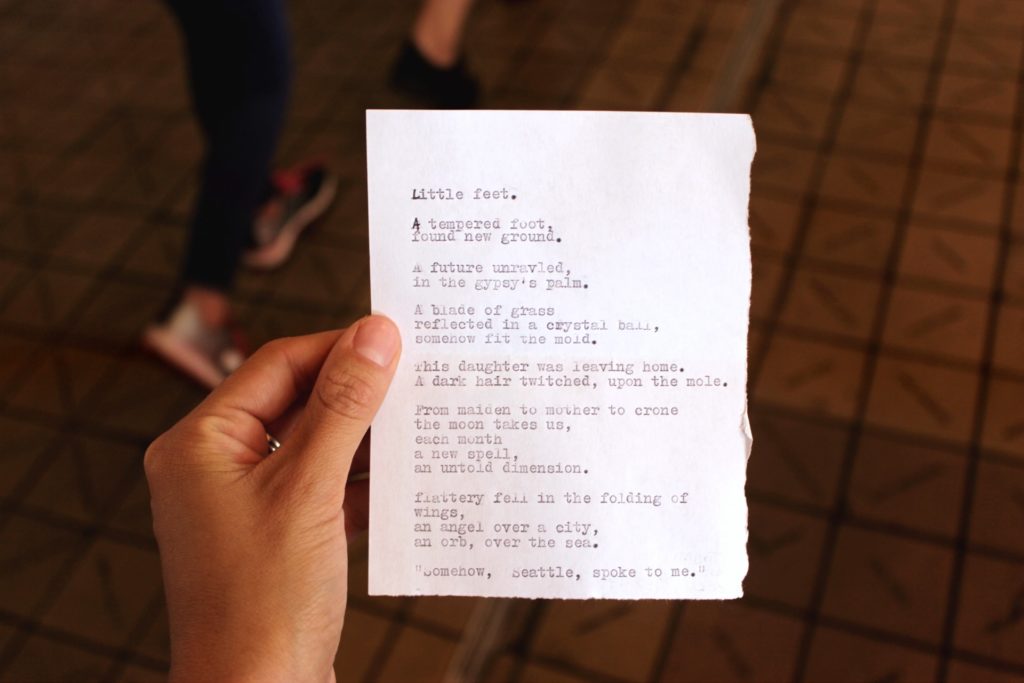
Let’s begin with the basics of screenwriting format. The first thing that separates scripts from other writing is the screenplay font. Scripts are always written in Courier New font.
Next is the screenplay title page. The title page is very important to the professionalism of your script. The title of your story should be centered on the page under the title should be By [Your Name Here].
In the bottom left corner, it is also important to add your contact information so if someone reading it likes your work, they can get in touch with you.
Another important tenet of the screenplay format is how a scene is established. Every screenplay starts with FADE IN: and then an extremely sparse description of the scene.
When writing your own, you should establish whether or not the scene is indoors or outdoors with either INT or EXT for interior or exterior and then give a one-word description of the location. Like OFFICE, PARK, GARAGE.
The last thing the opening line of a screenplay needs is a time of day. Establish this with either DAY or NIGHT. With just three words the scene is set in proper screenwriting format. A screenplay format example of this might look like.
FADE IN:
INT. COTTAGE. DAY.
Lastly, another great way to get the hang of writing in script format is to read lots of scripts. It’s fairly easy to find free screenplays of your favorite movies, like the Pulp Fiction screenplay, online. By reading and becoming familiar with the formatting it will be easier to write.
Why Does Screenplay Format Matter?

If you’re making an experimental film or a documentary, a proper screenplay may not be right for you. In other blogs, we’ve talked about the disadvantages of formatting.
It might seem frivolous to write within these specifications, but using the correct script formatting is actually very important if you’re writing a narrative film.
It Shows Your Experience
By correctly formatting your script, it shows producers and other creatives you know what you’re doing.
When sharing your script with others in the industry, you want to put your best foot forward, and having correct formatting is the way to do that.
Advance in Screenplay Competitions
And if you’re submitting your script, contests get hundreds of screenplay submissions, and having correct formatting is the easiest way to make it past the first round of cuts.
Scripts with formatting errors will not even be considered by major agencies or in screenplay competitions and screenplay contests.
Helps with Pacing
The way scripts are set up also allows for easy reading. When writing dialogue specifically, each new line of dialogue gets its own new line on the page.
This allows for the pacing of the scene to be determined easily from a read through. And with ample white space, the page looks relatively clean, and it’s easy to read. This is another metric studios use to sort through scripts.
If your script isn’t correctly formatted, it will be hard to read, and the reader will have to do extra mental work when noticing the formatting errors, ultimately distracting them from your story. This will get your script tossed in any screenwriting competition.
Advantages and Disadvantages

Advantages
The screenwriting format does have advantages. The screenplay font, Courier New, keeps everything looking neat and uniform. The screenplay title page is a long tradition in screenwriting and offers a clean looking introduction to your story.
Screenwriting software can help make writing your screenplay easier and there are plenty of free screenwriting software options. Looking at sample screenplays and screenplay examples can help inspire your ideas and creativity.
It’s not realistic to assume that you’ll write the Pulp Fiction screenplay on your first try but sometimes you don’t need a screenplay to make a great film.
Sometimes just a screenplay outline or a screenplay treatment is enough of an idea to get working on the production. A treatment is a summary of your story, your characters, their arcs, and which themes you want to address. This plus a tight shooting schedule can be all you need to make a great film.
Plenty of great films have been born without a pre-planned script. Including Sunset Boulevard, Jaws, and Ironman.
Disadvantages
If you’re producing your own project, maybe you don’t have to write down your ideas into screenplay software and type out the whole script. Especially, if it’s just you and a small crew, trying to follow a script to the letter might hinder your project instead of helping it.
If you’ve worked with your cast and crew before and they trust your direction maybe taking a screenwriting course isn’t necessary for your project. It’s so great to have a crew and cast that you can trust and that has faith in you. This trust is crucial on set because it allows you to take more risks with the story and it allows your crew to feel like they are in good hands. Additionally, sometimes having a script on set can hinder experimentation and improvisation among actors.
When Screenplay Format Might Not Matter

Improvisation
There are plenty of times when a screenplay format example is a good indicator of a good film but if your project is focused on improv, a screenplay is not going to help your project.
Recently, comedians Ben Schwarz and Thomas Middleditch put out three improvised specials on Netflix. In this case, the director and producers of this special were not completing online screenwriting courses before this project, instead, they understood that by the nature of the project, a script is not necessary.
Experimental Film
If your project is experimental, again, a fully formatted script might not matter. The most important aspect of experimental film is the idea or concept, once that has been established, production can begin and screenplay competitions or screenplay contests are not usually useful for such projects.
Many times during experimental work, changing or adapted is necessary for the art being made. With a fully formatted screenplay, this is harder to achieve.
Working on Your Pitch for Funding
An important aspect of preproduction is securing funding. Sometimes you might think you need your fully formed script before you can start looking for funding but that’s not true. Sometimes you’re just looking to validate your pitch concept before embarking on a fully-fledged screenplay.
In the idea and pitching stage, you often don’t need to worry about screenplay formatting just yet. Just focus on the meat of your story, what it’s really about, and how you’ll produce it. Here at The Film Fund, we structure our funding opportunities around the one-sentence pitch. Head over to our contests webpage to check out the details, and submit your pitch.
Agency Work
Additionally, not all projects are narrative stories. If your shoot is mostly product shots and non-narrative agency shoots because you’re an ad agency screenplay format is not your concern. Agencies are not concerned with how to end a screenplay, or how to get a screenwriting agent.
Instead, they are focusing on how to sell products and reach audiences. Screenplay formatting does not lend itself to achieving these goals.
Documentary Work
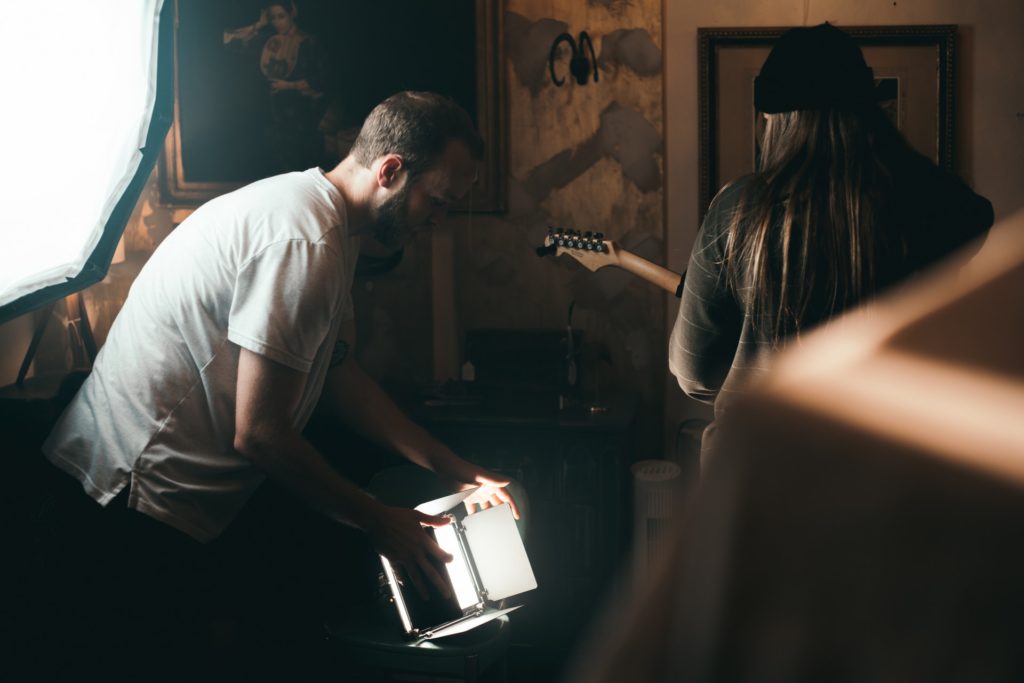
Lastly, if your project is a documentary it is hard to know what kind of footage you are going to capture before you begin shooting. With that in mind writing up a script in screenplay format beforehand is impractical. There are often not screenwriting competitions for documentaries for this reason. Documentaries are usually pieced together in editing as the director uses the footage to put together the story they want to tell.
How to Write a Script with Perfect Screenplay Format
Screenwriting format serves as a great tool when writing to keep your ideas clear and your script cohesive. Writing with proper formatting also gives your script legitimacy, and it lets people reading it know that you know what you’re doing.
Resources

Software
The easiest way to write with perfect formatting is to have the right tools. Screenwriting software can be a very helpful tool because it can keep your formatting correct as you write.
If you don’t mind paying for it, Final Draft is the industry-standard screenplay software and very easy to get the hang of. If you’re a student, you’re in luck: Final Draft offers a semester-long free trial, which is a great way to learn the tools and format at a competitive industry level.
If you’re looking for free screenwriting software Scrivener, Manuskript, and Celtx are all great options. This post offers some more great free software.
Books
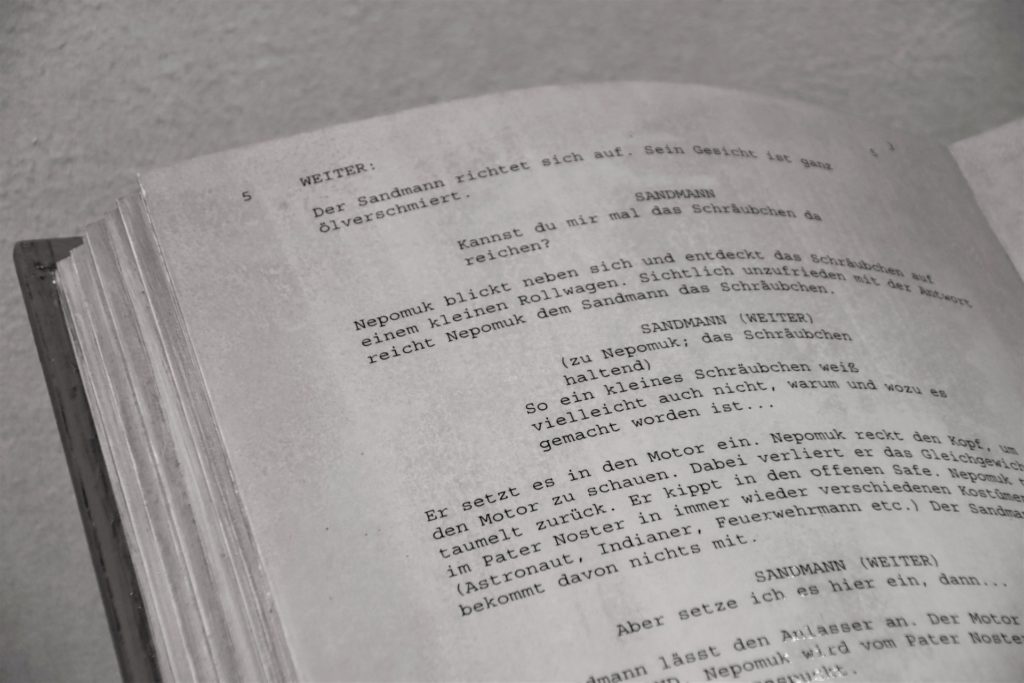
Books about screenwriting are also great resources because you can go back to them again and again for help when you’re writing. Books also have plenty of screenplay examples and excerpt samples from screenplays.
Scriptwriting books can also be a great resource for writing a screenplay outline and in general offer great screenplay format examples.
Some of the best books for writing screenplays and the best screenwriting books for beginners are available here. You can find some great screenwriting books on Amazon.
Courses
Lastly, a great resource is a screenwriting course. Especially in quarantine when things are moved largely online, an online screenwriting course could be very beneficial for your writing. Getting feedback from other writers and industry creatives can be very beneficial for your work. Courses can also teach how to write something specific like a screenplay treatment, which is a one-page summary of your script.
A step further would be entering a screenwriting fellowship, which we would recommend if you’re really serious about screenwriting as a career. The Writer’s Guild Foundations has a great list of fellowships for the coming year.
Writing

Title Page
The first step to writing with perfect formatting is the title page. Any good screenplay has to start with the title. The screenplay title page is very important to the professionalism of your script. The title of your story should be centered on the page in the official screenplay font, which is Courier New, and under the title should be By [Your Name Here].
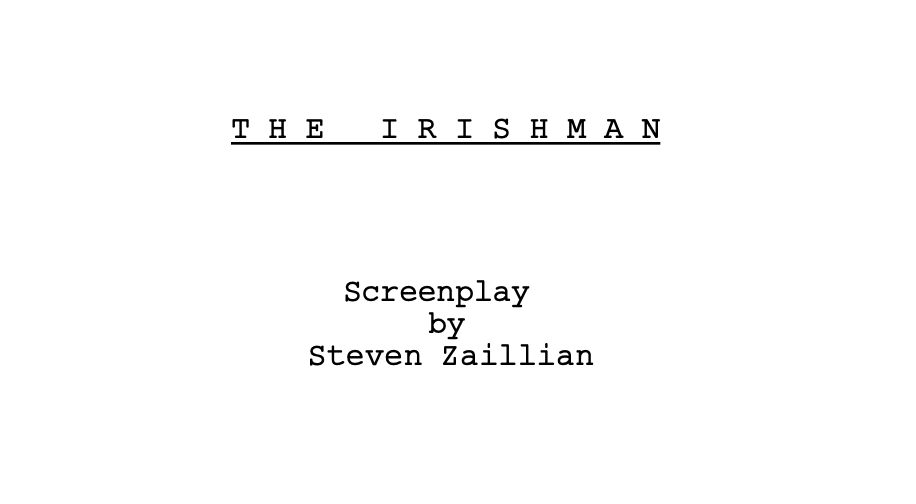
In the bottom left corner, it is also important to add your contact information so if someone reading it likes your work, they can get in touch with you. You can also add your copyright information here once you choose to copyright (although that’s a bit of a different blog post). Now that you’re set-up, you’re ready to write with perfect formatting.
Scene Headings
The other important convention of formatting is how the script begins and how each new scene is introduced. Every screenplay, even famous ones like the Pulp Fiction screenplay, start with FADE IN: and then a sparse description of the scene.
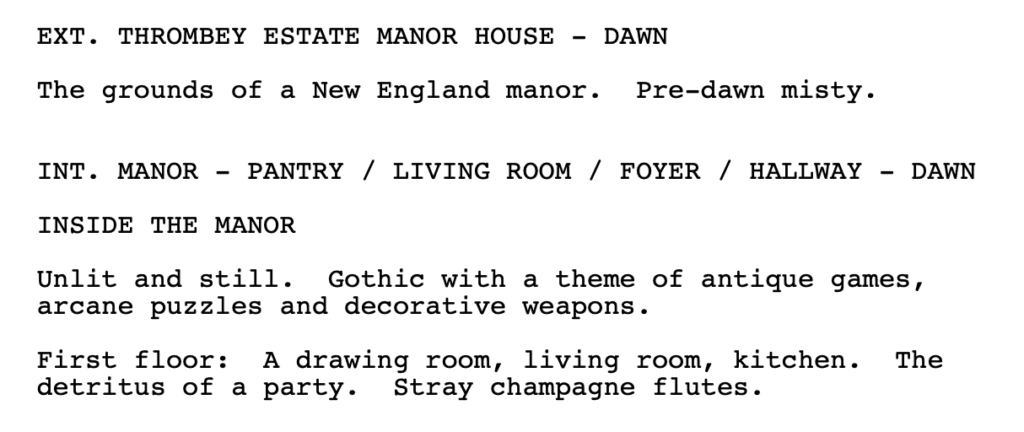
Establish whether or not the scene is indoors or outdoors with either INT or EXT for interior or exterior, and then give a one-word description of the location. Like OFFICE, PARK, GARAGE.
The last thing the opening line of a screenplay needs is a time of day. Establish this with a dash—either DAY or NIGHT. If you’re continuing a scene from a different location without interruption in time (such as characters exiting a room, walking into a restaurant, etc.), you can use the word CONTINUOUS.
With just three words, the scene is set in proper screenwriting format. A screenplay format example of this might look like.
FADE IN:
INT. COTTAGE — DAY.
Dialogue
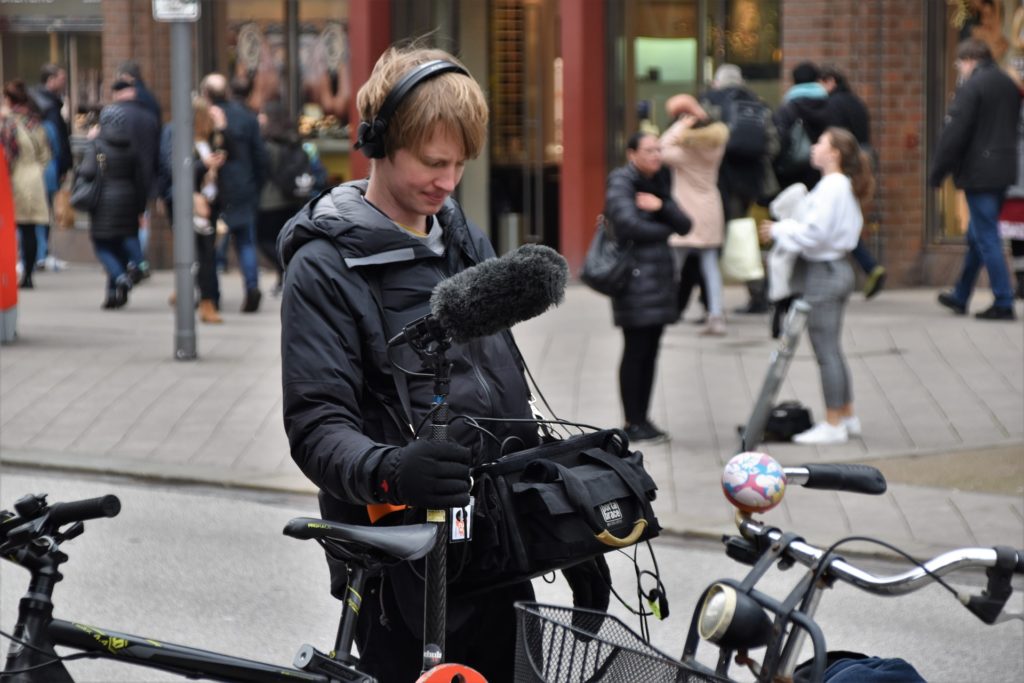
The way dialogue is written in screenplay formatting is unique and has important formatting conventions. There are no qualifiers like “she said” in screenplays. Instead, in a script, the line of dialogue is written under the speaker’s name in all caps, as MAX followed below by the line of dialogue. Screenplays also don’t use quotation marks for dialogue.
By giving each new line of dialogue its own new line of the page, the pacing of the scene can be determined from a read-through, and the page looks relatively clean with ample white space.
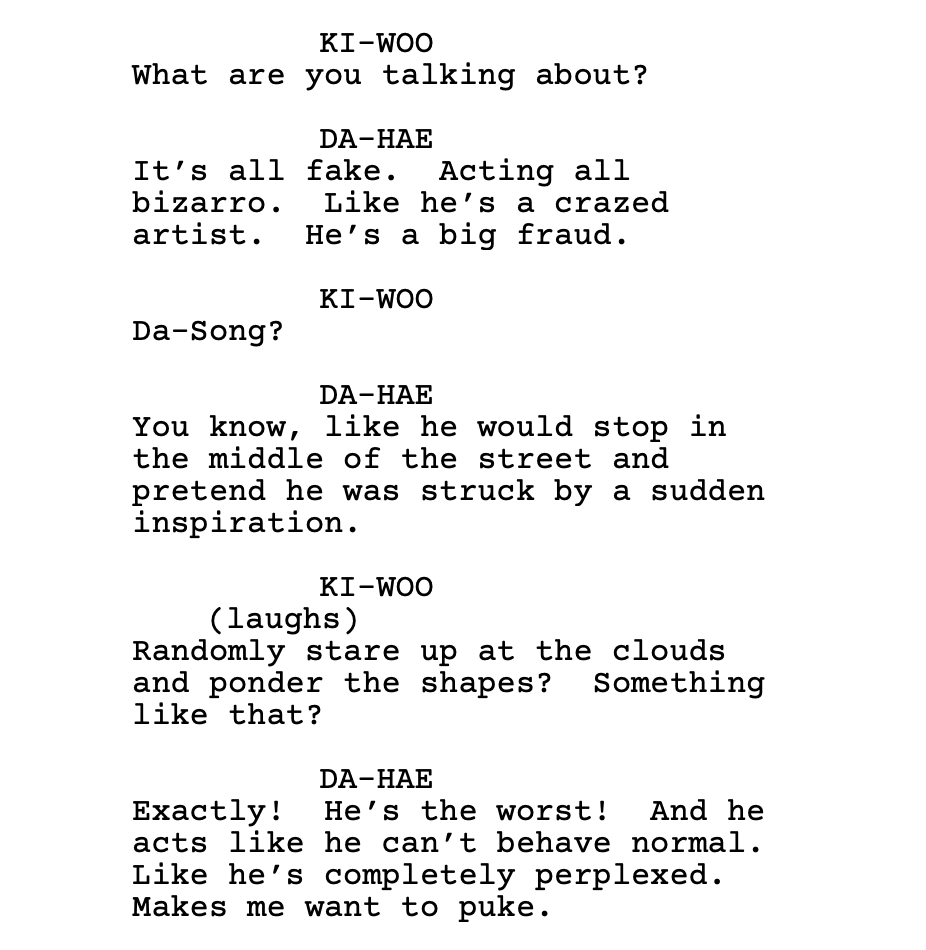
White space is important for the reader. A screenplay submission that is formatted incorrectly and has long blocks of text will not be considered because it is too hard to read.
White space makes reading easier on the eyes and is metric studios use to sort through scripts. Don’t write more than three or four lines without a line break, as this will be too hard on the reader’s eyes. It will also help the pacing of your script.
For a better understanding of how this looks, you can find free screenplays for several famous movies online with just a quick Google search. Reading other screenplays can be very beneficial for writing your own.
This is the script for Bong Joon-Ho’s Parasite, and this is the script for Rian Johnson’s Knives Out, and Marc Forster’s Stranger Than Fiction just to name a few examples you can check out.
How to End a Screenplay with Proper Format

In screenwriting, there is less expectation to conclude the story by tying up all loose ends. Think about how many movies end leaving you wanting more. A movie that uses its open ending capabilities purposefully is a test to a good screenplay formatting. Depending on the genre and the type of story you want to tell, you could end your script in the middle of the action by including the words FADE OUT.
A lot of French New Wave films such as Breathless, or even contemporary films such as The Florida Project, end in what seems like the middle of the action. But ending your script with FADE OUT is imperative, even if you don’t intend on the actual movie “fading out” in the edit (although, this decision is really up to the director), as it signifies to the reader that the story has concluded.
If you think you’re really serious about getting into scriptwriting you can do a couple of things. You could join a screenwriting fellowship and gain insight from fellow writings while working on your own scripts. Scriptreader Pro put together a list of fellowships for the year.
You could also get a screenwriting agent if you were looking to go the Hollywood route. An agent will represent you and your scripts to studios and executives.
Having representation adds legitimacy to you and your scripts which can be helpful if you want to sell your stories to studios. There is no one right way to become a screenwriter, which is good! Whatever way it can happen for you will be the right way, so get out and get writing.
Ensure Proper Formatting with Screenplay Tools

Before you can start writing, you need the right tools. Some of the best resources that you can return to again and again would be a screenwriting book.
Here’s a list of some of the best books to purchase.
Books also offer great screenplay examples in them. It can be very beneficial to look at some finished sample screenplays while you’re writing your own.
Another great tool is screenplay software because it can work as a guide as you write. If you don’t mind paying for software, Final Draft is the industry standard and very easy to get the hang of. If you’re a student you’re in luck, Final Draft offers a semester-long free trial, which is a great way to learn the tools and format at a competitive industry level.
If you’re looking for free screenwriting software Scrivener, Manuskript and Celtx are all great options. This post offers some more great free software.
Online screenwriting courses are also great places to learn about formatting. Especially now when classes and courses can’t be held in person, an online course might be a great way to get help with a screenplay outline or screenplay treatment.
After You’ve Written
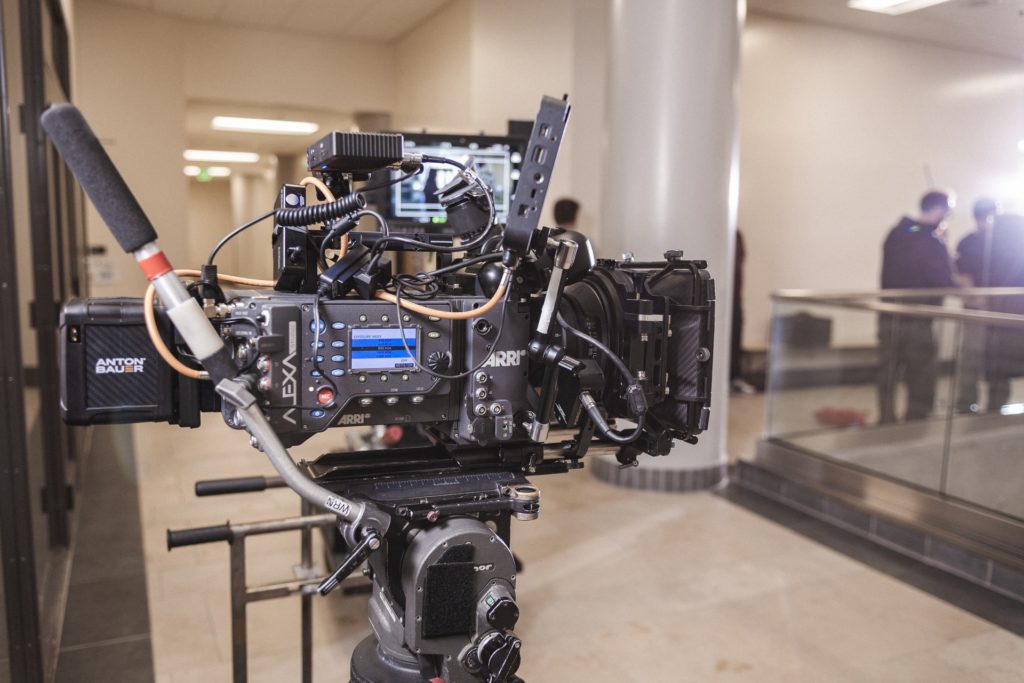
So what do you do when you’ve figured out how to end the screenplay and it’s done? There are lots of different ways you can go about becoming a screenwriter and getting your script out there.
Screenplay competitions and screenplay contests are a great way to get other people to look at your work and get some good feedback. Here are some of the best screenwriting competitions according to Studio Binder.
If you’re looking for a more traditional Hollywood route to get your script noticed, you can get a screenwriting agent. An agent helps advocate for you and your script to studios and Hollywood executives.
Whichever way you go about getting your script noticed, it’s important that it is properly formatted, otherwise, the people reading it won’t take it seriously. Perfect formatting lets your readers know that you’re a professional.
More Screenwriting Format Tips
What do you do when you get a great idea in your head? When that sudden burst of inspiration comes when you’re standing in the grocery store? Usually, you write it down in your phone, a little blurb in the Notes app. Could this idea become the next big movie, television show, or novel?
You’ll never know until you actually sit down to write it out. And when you do, it’s more efficient to write in Screenplay formatting.
Screenplay Format Software
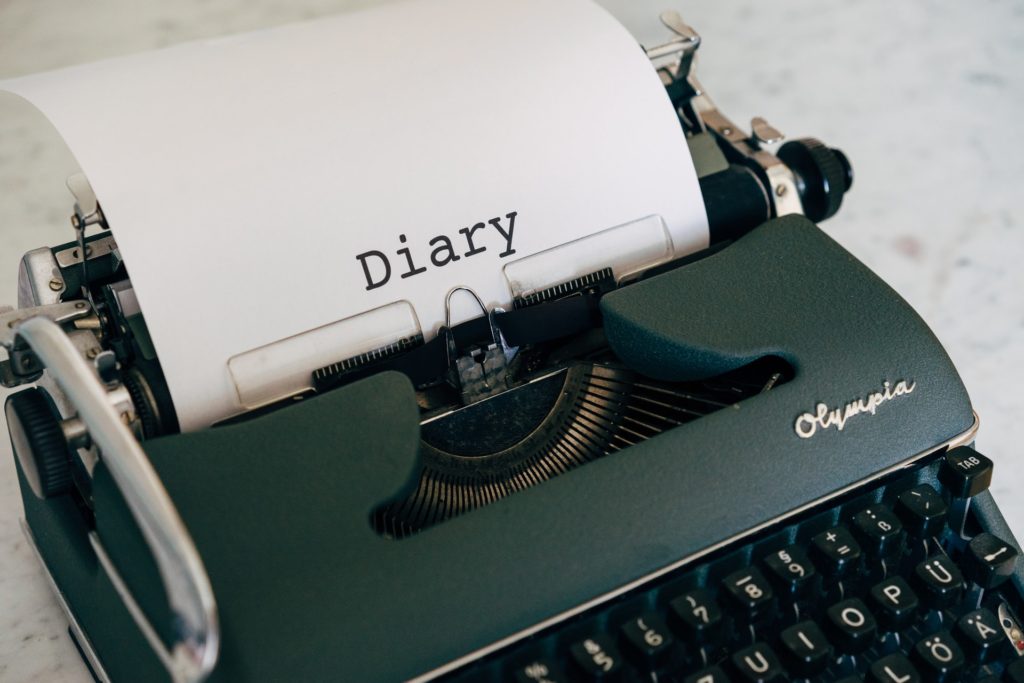
But first, you’ve go to get your hands on some good screenplay software. If you don’t mind paying for it, Final Draft is the industry standard and very easy to get the hang of. If you’re a student you’re in luck, Final Draft offers a semester-long free trial, which is a great way to learn the tools and format at a competitive industry level.
If you’re looking for free screenwriting software Scrivener, Manuskript and Celtx are all great options. This post offers some more great free software.
Barebones Format
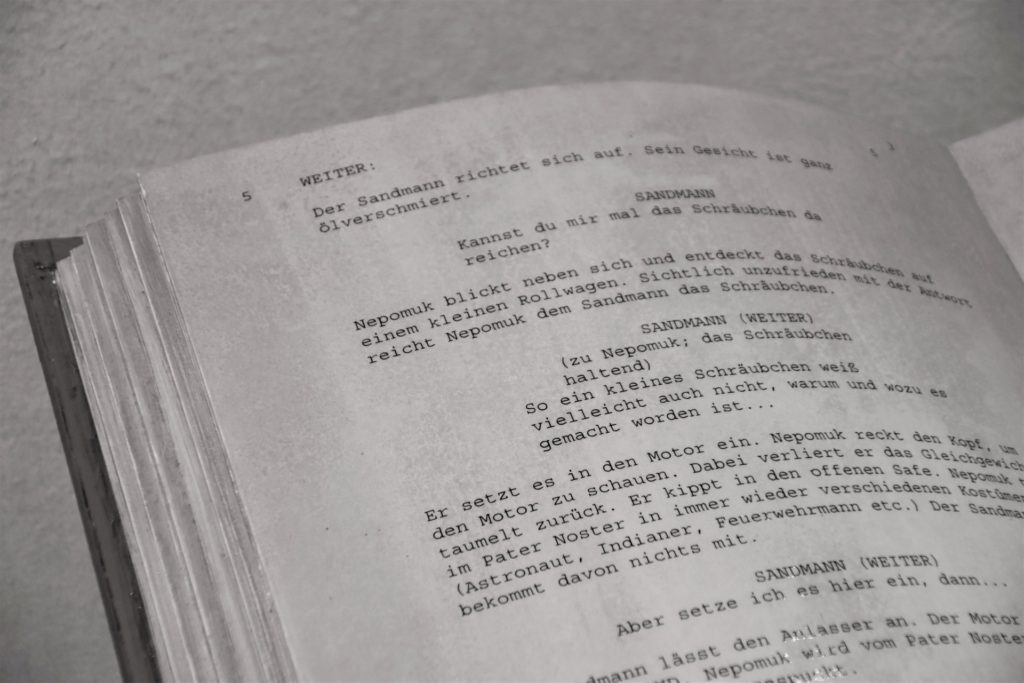
Any good screenplay has to start with the title. The screenplay title page is very important to the professionalism of your script. The title of your story should be centered on the page in the official screenplay font which is Courier New and under the title should be By Your Name Here.
In the bottom left corner, it is also important to add your contact information so if someone reading it likes your work, they can get in touch with you. Now that you’re set-up, you’re ready to write efficiently.
Firstly, Screenplay formatting comes with all kinds of conventions and special tools for a good flowing screenplay. Ever screenplay starts with FADE IN: and then an extremely sparse description of the scene. Establish whether or not the scene is indoors or outdoors with either INT or EXT for interior or exterior and then give a one-word description of the location. Like OFFICE, PARK, GARAGE.
The last thing the opening line of a screenplay needs is a time of day. Establish this with either DAY or NIGHT. With just three words the scene is set in proper screenwriting format. A screenplay format example of this might look like.
FADE IN:
INT. COTTAGE. DAY.
Establishing a location like this in prose writing could take either a paragraph or the entire page, its completely up to the writer. In prose writing, there is no structure like there is in screenwriting. Establishing the scene could take as long as the writer chooses.
Some writers like using rich details to build worlds and some keep their descriptors short. Neither is incorrect or makes for bad writing, but for efficiencies sake, screenwriting formatting is a system built to make writing productive.
How To Write Emotion
Secondly, a good tool for effective screenwriting is to never write what can’t be shown on camera. This means that the camera can’t capture internal feelings like loneliness, helplessness, joy, or fascination. The only thing the camera can track is action. So for a good screenplay, it is important to focus on actions that can portray those emotions.
A screenplay example of this would be instead of writing that a character felt lonely, a more efficient way would be to say ‘the character looked around and saw that they were alone.’ Screenplay formatting does not get bogged with the character’s feelings or internal reactions like prose has the capacity to.
Instead internalized things are shown through action or an internal monologue which can also help deliver information to the audience. The screenplay format does not function well with elaborating on the internal feelings of characters, this means that the writing process can be succinct because its focus is on the action.
Exposition
Thirdly, screenplays often stay away from the belabored exposition. Similarly to establishing location, how exposition is created in prose is up to the style of the writer. There are no conventions about how much exposition is necessary and how to include it.
Often in prose, the beginning of any story is expected to be exposition, with the introduction of characters and relationships. In screenwriting the exposition is supposed to be woven throughout the beginning of the plot. This is because it is often boring to watch exposition play out on screen.
When writing screenplays this makes the process more efficient, because you can begin with the action right away. The trick to creating exposition in a screenplay is to only include what is necessary for the audience to know, and to do so naturally. What the audience needs to know in a movie is far less than what they expect to know from reading a book of prose. This makes the screenplay format and an efficient tool for writing.
Dialogue

Additionally, the way dialogue is written in screenplay formatting is unique and different from prose. There are no qualifiers like ‘she said’, ‘he exclaimed’ in screenplays. Instead in a script, the line of dialogue is written under the speaker’s name in all caps, like MAX: followed by the line. Screenplays also don’t use quotation marks.
By giving each new line of dialogue its own new line of the page the pacing of the scene can be determined from a read through and the page looks relatively clean, with ample white space. This makes the reading easy on the eyes and is metric studios use to sort through scripts.
It’s also a productive way to write, hitting a page count in a screenplay is a lot easier than in prose. All of the tools outlined here can be seen in famous screenplays of critically acclaimed movies, like the Pulp Fiction screenplay by Quentin Tarantino. A great way to become familiar with the conventions of screenplays is to look at sample screenplays or examples of free screenplays online. Often times you can find the scripts for your favorite movies on Google!
The Ending
Once you’re done writing you have to think about how to end a screenplay. Prose and screenwriting differ here again. When writing prose there is an expectation to wrap up the story at the end, to come to a satisfying conclusion.
In screenwriting, there is less expectation. Think about how many movies end leaving you wanting more. A movie that uses its open ending capabilities purposefully is a test to a good screenplay.
Another benefit to the efficiency of the screenplay format. Of course, all of these decisions can be flushed out in a screenplay outline. Similarly to prose, having an outline always helps the writing process.
Practice and Opportunity

If you really think screenwriting might be your passion a great way to get practice, learn the tools, and have others read your work is in a screenwriting course. What better way to learn than with your peers who are also interested in the difference between prose and screenplay and are passionate to learn. Academic screenwriting fellowships might be a good fit for those already in higher ed or those who are seeking the notoriety of a fellowship.
For those who are looking for a good community of amateur writers, an online screenwriting course might be for you. Good online classes can be found at masterclass.com The screenwriting one is taught by Aaron Sorkin!
Once you have your screenplay, it’s been edited and work-shopped you’re ready to send it out. If you want to go the Hollywood route with your script you’ll have to write up a screenplay treatment. A treatment is a summary of your script. It highlights the characters, their arcs, and the main conflicts and themes of your story.
Executives rarely read scripts but they’ll read your treatment! Another good tool to have when send your script around Hollywood is to have a screenwriting agent.
Hollywood
If you don’t think Hollywood is for you or your screenplay, you can go with the festival and competition route. There are plenty of screenplay competitions and screenwriting competitions. The blog Studio Binder offers some great resources. This particular blog offers some great options for screenplay contests.
Don’t be afraid to get your screenplay out there! Any place that’s advertising for screenplay submissions, submit yours! You never know what might happen.
The screenplay format lends itself so perfectly to efficient writing, get out there, and write YOUR screenplay!
For More Tips Like These, Sign Up For Our Newsletter
[fc id=’6′ type=’popup’][/fc]